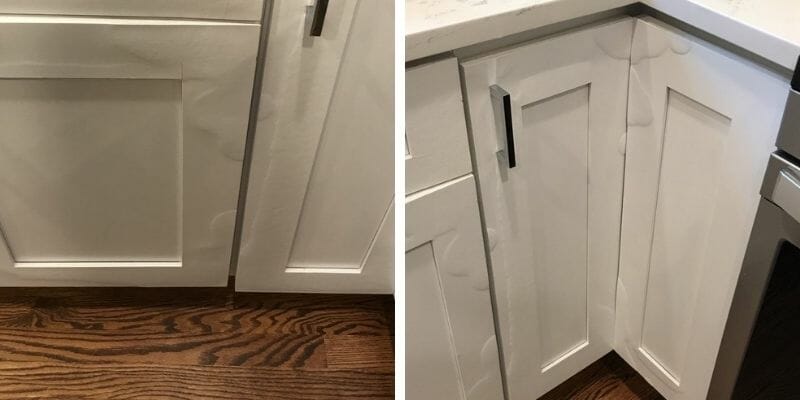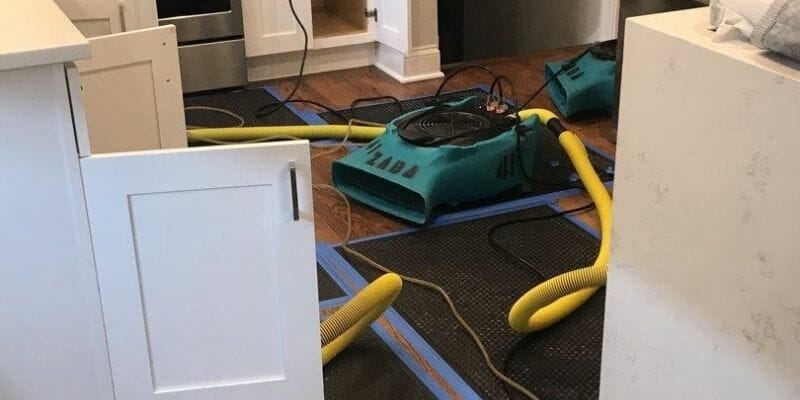Do you have water damaged kitchen cabinets?
If so, acting quickly is essential.
Over time, water can destroy the outer shell of your kitchen cabinets, damaging the finishing and darkening the wood.
In some cases, water damage can also render your cabinets useless, especially in cases where you’re dealing with a water leak in the cabinets under your kitchen sink or a similar issue.
If your cabinets are made of a material like plywood, delamination, and warping can be serious enough to require a total cabinet overhaul.
While it is possible to learn how to repair water damaged MDF or plywood kitchen cabinets, especially if the repairs are minor, it’s always smart to hire a professional to evaluate the damage and help you come up with a plan of action.
With that in mind, here’s what you need to know about water damage in your kitchen cabinets.

How Does Water Damage My Kitchen Cabinets?
Although they’re made differently, plywood and MDF are wood-based products. Both are durable materials for kitchen cabinets, but they aren’t waterproof.
Badly soaked MDF swells, distorts and crumbles. Water-damaged plywood buckles as its layers split and splinter.
Wet cabinets also spread water damage to other areas of the kitchen. Moisture wicks into dry cabinets, baseboards, flooring, and drywall.
The dark, damp space creates an ideal environment for mold and mildew. Fungal growth multiplies in as little as 24 hours and quickly migrates into surrounding materials.
How to Repair Water-Damaged Kitchen Cabinets: 3 Steps

If you have water damage under your kitchen cabinets, here are the steps you’ll need to take to resolve the issue:
1. Evaluate the Damage
First things first: you’ve got to understand exactly how serious the damage under your kitchen cabinets is. This will depend, in large part, on whether your cabinets got wet due to a burst pipe, high humidity, or leaking water.
As you evaluate your cabinets, consider whether or not they are structurally sound:
- Are the glue joints stable?
- Has the plywood warped?
- How much of the cabinet is damaged?
- Is the bottom shelf of the cabinet strong enough to hold weight, or is it sagging and waterlogged?
- Has delamination occurred?
Answering these questions will help you come up with an action plan for your cabinets, and will make it easier to communicate the extent of the damage to the professionals.
2. Evaluate the Structural Damage
Now that you understand the scope of the structural damage, it’s time to consider what must be done to repair it. Allow the dampness to dry before you take this step.
Once the cabinet is dry, you can evaluate the damage further, and gather supplies. As a general rule, it’s smart to have carpenter’s glue, clamps, and screws on hand.
Keep in mind that a professional will carry these items if you intend to hire one.
While the exact fixes required will depend on the extent of the damage, most service professionals will begin to fix a delaminated cabinet by spreading glue between layers of delamination. Once the adhesive is spread, they can clamp the sheets together with C-clamps.
Wondering how to repair water-damaged particle board cabinets?
Start by checking for separating bracing. If you find any, it means you may need to have the old braces taken down and reset with new screws and glue. The screws will draw your cabinet together and make it easier to restore stability.
3. Replace Damaged Parts
If you notice that there are parts of the cabinet that are damaged beyond repair, it’s time to replace them.
For example, the bottom shelf of your under-sink cabinet may be waterlogged and sagging, and replacement is likely the only option.
Keep in mind that this process can be complicated, and it’s wise to have a professional view of the situation before you decide how to proceed.
Get a Professional Opinion

If your water damage is severe at all, it’s wise to hire a professional to take a look. Even if the water damage seems minimal, having a professional assess the situation is essential.
In many cases, there can be additional water damage or mold hidden in the layers of the cabinets, and having the damage professionally repaired is one of the only ways to prevent it from spreading further.
MDF vs. Plywood: What’s the Difference?
Your kitchen cabinets are likely made of either MDF or plywood.
MDF stands for medium-density fiberboard. It’s an engineered wood composite material that’s very similar to particle board but is stronger and denser. It’s also cheaper than plywood, and smooth, so you don’t have to worry about knots or imperfections in the surface.
Plywood, on the other hand, is also an engineered wood product but is made by binding sheets of wood veneer together into a single, solid piece.
Plywood is available in different thicknesses and grades, so it’s always possible to find a good one for your project. Plywood is also stronger than MDF, and won’t be as susceptible to water damage when it gets wet.
Can Water-Damaged Wood Be Repaired?

As we’ve noted, wet cabinets can be cleaned, dried, and repaired. However, it’s difficult to work with badly damaged MDF and plywood.
Both materials can be salvaged, but the process requires special drying equipment and techniques.
Consider contacting a certified restoration company. Their technicians can assess the kitchen cabinets and explain your options for repairs or replacement.
An experienced water damage professional can often restore water-damaged cabinet doors, walls, and shelves.
How Can I Protect My Kitchen Cabinets From Water?
If you enjoy DIY projects, you can laminate your kitchen cabinets. The job consists of applying a smooth, water-resistant material to exterior cabinet walls and doors.
Laminating is an effective way to protect cabinets and change the looks of your kitchen, but it doesn’t completely waterproof the cabinets.
The following tips also help protect kitchen cabinets from water damage.
- Caulk Seams – Keep sinks from leaking around edges by caulking seams between sink edges and countertops.
- Caulk Backsplashes – Finish caulking in the kitchen by sealing gaps between backsplashes and countertops.
- Improve Ventilation – Smart exhaust strategies, open windows and splatter guards help reduce kitchen humidity.
- Check for Leaks – Routinely check for leaks around kitchen supply lines, drains and appliances.
- Jump on Spills – Quickly cleaning up spills reduces the chance of water seeping into cabinets.
Dealing with Water-Damaged Kitchen Cabinets in Chicago? We Can Help!

If you’ve got water damage in your kitchen cabinets, you’re not alone. When you consider that 14,000 people in the U.S. experience water damage daily, it’s easy to understand how common the problem is.
If you’re looking for a professional to help assess your water damage, contact ServiceMaster by Zaba. Your reliable, local service company in Chicago, we’ll help you repair your kitchen cabinets to full functionality: 773-647-1985